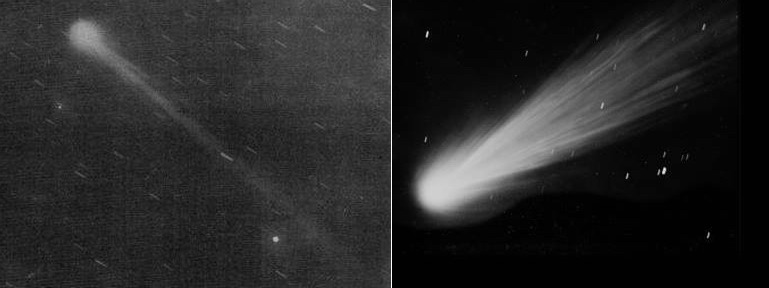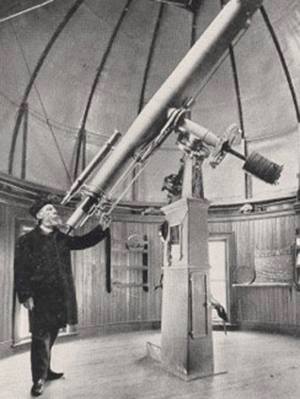Comet C/1911 O1 (Brooks)
William R.Brooks was born in Maidstone, Kent, England on 11th June,1844.
His father was a Baptist minister and in 1857, he immigrated with his wife and son to the U.S.A, and made home in Marion, New York.
William married a woman named Mary E. Smith in 1870 and moved to Phelps, New York, where he took up the position of village photographer.
He later travelled to Australia and became interested in astronomy as he watched the ships captain use a sextant to determine the angle between the stars and horizon for the purpose of celestial navigation.
He went back to Phelps and began to construct his own telescopes, and in 1881 he was rewarded in discovering his first comet.
Discoveries came quick and fast, and just as well, for discovering a comet in those times was richly rewarded and William soon was quite wealthy, 1886 saw him find 3 comets alone.
William's success was noticed by fellow Englishman and wealthy nurseryman William Smith.
Smith wanted to bring Brooks to Geneva and so as an ultimate lure he created a state of the art observatory and a house for Brooks and his family. How could he refuse ?
At his new observatory he photographed celestial objects , a practice that he was a pioneer in and also he lectured and taught at Holbart College.
His research at the Smith observatory was to be rewarded by 16 other comet discoveries.
William Brooks Died on May 3rd, 1921, and was well decorated within the astronomy world.
He received medals from the Lick Observatory , the Astronomical Society of the Pacific, the International Jury at the St. Louis Exhibition, the Astronomical Society of Mexico and the Lalande Medal of the Paris Academy of Sciences (1899).
He was also named a Professor and Honorary Doctor of Science by Hobart College.
His final discovery was that of comet C/1911 O1 , a month before his 67th birthday. Below is the story of that last discovery by a man who discovered 27 comets, just being beaten by Jean-Louis Pons (1761-1831), who found 28.
Discovery.
In the morning of July 21st,1911, William was was sweeping the eastern sky from the Smith Observatory, New York, when he discovered a faint comet of magnitude 10 in the constellation of Pegasus which was moving slowly north west in motion.
The following day other observers had noted it and also verified it to be magnitude 10 , with a nuclear magnitude of 11 and coma of 5' in diameter.
Apparition.
The comet was approaching both the Earth and Sun and so duly began brightening quickly, and by August the first was magnitude 8. By the 20th it was magnitude 5.5 with a coma 10' in diameter.
Its northward motion against the stars ceased on September the 12th, at a height of 57 deg, and so after this date it began to move rapidly southward.
Closest approach to Earth came on September 19th at a distance of 0.51 AU, with observers noting it to be magnitude 4.
The comet moved away from the Earth after this but was still approaching the Sun and at the end of September it had reached magnitude 3, with a 20 degree tail.
Interestingly, on October first, a respected double star observer, W.Doberek, noted a "double nucleus" with the two components some 2" apart. No other observation was made of this event and so one must believe this to have been an error.
Perihelion came on October 28th, at a distance from the Sun of 0.49 AU, with the comet now reaching magnitude 2, with a 30 degree tail.
Fading was rapid after perihelion and by November 21st, the magnitude had fallen to 5 with a coma diameter of 1'with a 2 degree tail.
By Christmas the comet was magnitude 8, and its last observation was on February 28th, 1912 when the magnitude was given as 11.
The comet seems to have been subject to brightness variants between August 20th and October 4th.
Orbital Characteristics.
Perihelion; 0.489 AU, 28/10/1911
eccentricity; 0.997005
inclination; 33.8095 deg.
Semi-major axis; 163.415
Longitude of the ascending node; 294.2071
Argument of perihelion;153.0045
Aphelion dist'; 326.341 AU.
Period; 2089.043 yrs.
Distance from Sun, 10th May, 2015 ; 112.366 AU.
The Comets Of William R.Brooks.
12P/Pons-Brooks
16P/Brooks 2
C/1883 D1 (Brooks-Swift)
C/1885 R1
C/1885 Y1
C/1886 H1
C/1886 J1
C/1886 K1
C/1887 B2
C/1888 P1
C/1890 F1
C/1892 O1
C/1892 W1
C/1893 U1
C/1895 W2
C/1898 W1
C/1902 G1
C/1904 H1
C/1906 B1
C/1911 O1
Below two images of C/1911 O1 (Brooks), and a picture of the great man at the eyepiece of the Smith Observatory.


Neil Norman.
Ipswich. England.
No results found.
